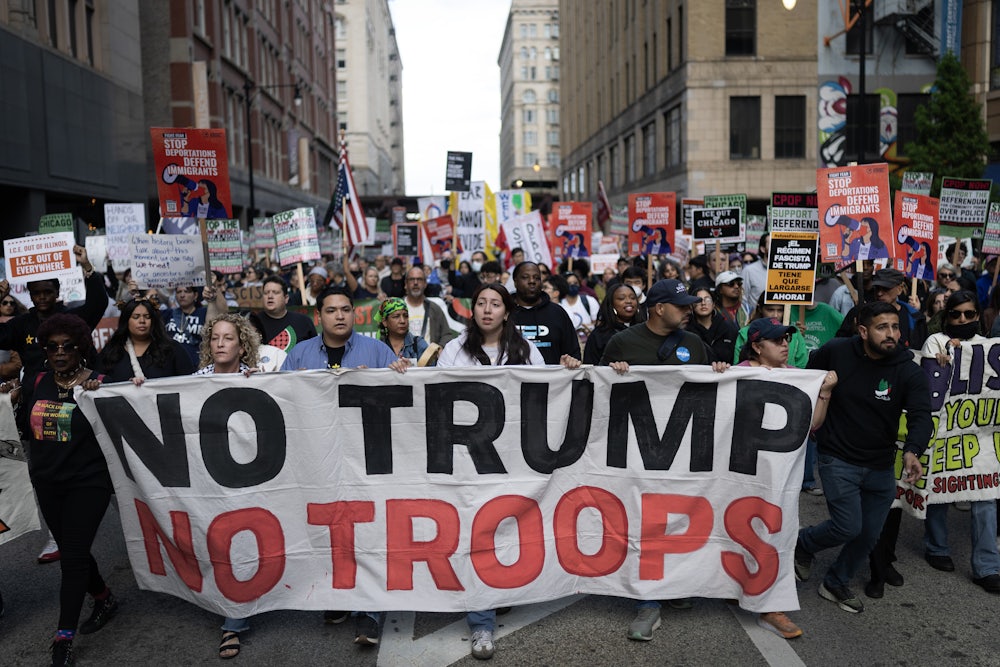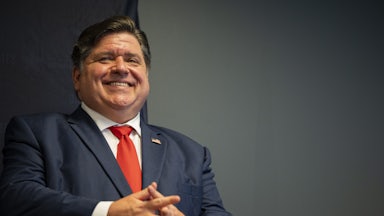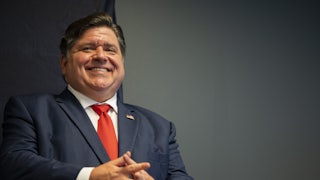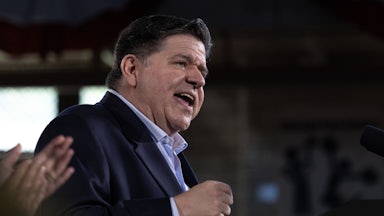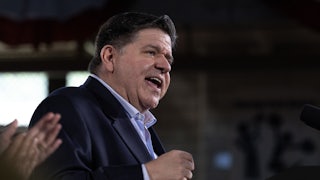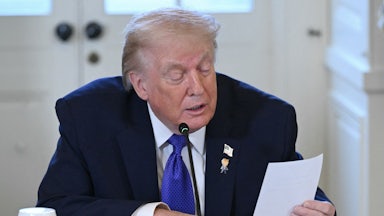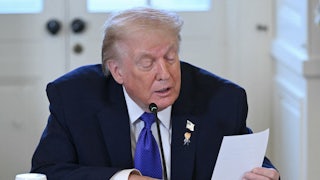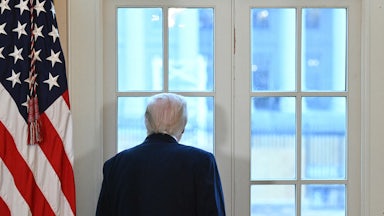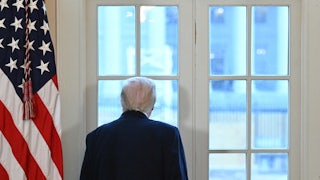On Saturday, September 6, Donald J. Trump, the president of the United States, apparently declared war on the city of Chicago. That is, unfortunately, not an exaggeration.
In a recent social media post, Trump riffed darkly on a famous line from the film Apocalypse Now, declaring: “I love the smell of deportations in the morning.” He then stated, with his signature lack of grammar and aggressively emotive capitalization, “Chicago about to find out why it’s called the Department of WAR.” Below that, a picture of the Chicago skyline showed Trump dressed as Lieutenant Colonel Kilgore—Robert Duvall’s character from Apocalypse Now—as helicopters fly over a burning Chicago, smoke billowing from the flames, with the title “Chipocalypse Now” scrawled across the bottom of the picture. The message was clear: The city of Chicago will be subjugated by the sheer force of the U.S. military—not because that city is in armed revolt, like the Confederacy in the 1860s, but simply because the president wants to do it.
If the president of the United States threatening a U.S. city with “WAR” is not a red line for constitutional democracy, then nothing is. Trump has since tried to downplay his rhetoric, but he was not making idle threats: He has already deployed the military to police two other large, Democratic-voting, racially diverse cities, Los Angeles and Washington, D.C. Additional cities, such as Baltimore and New York, are on his wish list for military deployments too. And while Wall Street may take comfort in his reputation for chickening out on certain destructive economic plans, Trump has been following through on his threats to deploy the military on American streets. Trump’s vision is for significant parts of the U.S. to exist under military occupation.
In the face of this sweeping mobilization of military force against the domestic population, three things are clearer than ever. First, one of the central components of Trumpism is the militarization of the U.S. government. Second, that militarization goes hand in hand with a politics of white supremacy. Third—and as a result of the first two points—the struggle against authoritarianism, the struggle for racial justice, and the struggle against militarization are deeply intertwined projects. Consequently, racial justice activism, pro-democracy activism, and antiwar activism must form a united front. Let’s take those points one at a time.
To begin with, one of the basic features of Trump’s approach to governing is to turn to the military to solve anything that he perceives as a problem. I wrote about this early in Trump’s first term, in an essay titled “Militarizing the Presidency”—a title that feels even more applicable now. In his second term, Trump is doubling and tripling down on militarization.
What do I mean by militarization? The gist is that Trump consistently wants to replace civilian policymaking with military action—including in many situations that do not seem remotely implicated in national security. That is because Trump sees the military as more decisive, less constrained by law, and more subject to his personal whim than the federal civilian bureaucracy. The recent rebrand of the Department of Defense as the Department of War is a particularly bombastic symbol of Trump’s view that aggressive military action is the best solution for every issue.
In Trump’s first term, his penchant for militarization meant that he preferred to have military officers, or retired military officers, in major policymaking positions. Think of James Mattis, H.R. McMaster, Michael Flynn, and John Kelly. Trump called them “my generals.” From Trump’s point of view, any problem could be solved through the muscular mechanisms of military deployment or national security powers, wielding Trump’s unilateral authority as commander in chief without going through the pesky details of the usual policymaking process.
In 2017, for example, it was telling that rather than seeking to change immigration law through congressional action, Trump implemented his Islamophobic views on immigration by declaring that it was a national security imperative to ban entry into the U.S. for individuals from multiple Muslim-majority countries. Similarly, in his second term, he has invoked national security powers to unilaterally impose enormous tariff-taxes on imports and to use the wartime Alien Enemies Act for immigration enforcement. His preference for military solutions to nonmilitary problems like enforcing criminal drug laws was recently made manifest when he used military force to execute alleged drug smugglers.
What Trump discovered in his first term, however, was that the military officers he appointed to leadership positions often turned out to have a sense of honor, which meant that they would not bow to his every whim, such as his desire to have Black Lives Matter protesters shot in the legs. So now, in his second term, Trump has sought to politicize the military. He is personally involved with promotions for high-ranking officers, in a departure from past precedent. His administration appears to have applied political litmus tests to soldiers in uniform. In line with broader efforts to control what is taught in universities and museums, the military academies are pulling books about racial justice, gender equality, and gay rights off the shelves. And then there was the military parade that Trump threw for his birthday.
Trump is thus not only turning to the military as his primary tool for carrying out government policies. He is simultaneously building a partisan-political military as his personal police force to impose his policy preferences on the entire country. The deployment of troops to help carry out immigration law, to serve as immigration judges, and to police ordinary crime in Washington, D.C., epitomizes Trump’s militarized approach to the presidency.
That leads to my second point: For Trump, the militarization of the government is a key tool for carrying out a deeply racist agenda. From the beginning of his presidential campaign in 2015, which he launched with a racist screed about Hispanic immigrants, Trump’s politics have been built on white racial grievance. And with the use of immigration agents clad in tactical gear, backed up by the U.S. military, to carry out his mass-deportation agenda, Trump clearly sees violent military action on U.S. streets as the best way to enact his white-grievance agenda. The same impulse is obvious in the Trump administration’s renaming of U.S. military bases to honor Confederate leaders—Confederate leaders who waged war against the United States for the purpose of preserving a system of racial slavery.
The interplay between white supremacy and militarization in the United States dates back centuries, of course. The historian Nikhil Pal Singh, for example, has cataloged a long history of racism, warfare, and policing in the U.S. Indian removal policies are one major instance, as are armed slave patrols in the antebellum period. In the 1920s, W.E.B. Du Bois criticized the fact that Marine General Smedley Butler—who had famously led U.S. military interventions throughout Latin America and built a militarized police force to control Haiti—was taking over and militarizing the domestic police force in Philadelphia too. Almost a century after that, one of the claims made by Black Lives Matter activists in the 2010s and early 2020s was, similarly, that surplus military gear from the war on terror, such as body armor and armored vehicles, was being shipped to local police departments across the country and then redeployed against Black people.
Trump’s embrace of simultaneously militarized and racialized domestic policymaking is thus far from new. But threatening to deploy “the Department of WAR” to Chicago, a racially diverse city with a Black mayor, for the purpose of enforcing immigration law, after Trump’s 2024 presidential campaign was filled with lies about Haitian immigrants eating pets, is one of the more spectacular instances since the U.S. Civil War of the militarization of society for the purpose of enforcing racial hierarchy.
What does all this mean? In light of the interplay between Trump’s authoritarian aspirations, his fondness for military solutions to any perceived problem, and the racist policies that he is carrying out by way of militarization, Trump’s authoritarian turn cannot be resisted without building solidarity across a wide range of domestic and foreign policy issues. Trump’s social media post about bringing “WAR” to Chicago makes it clear that racial justice politics and pro-immigrant politics are intertwined with antiwar politics. Demanding equality also means resisting the militarization of policing and policymaking—and vice versa.
As I have written before, Black antiwar activists like Du Bois, Martin Luther King Jr., Pauli Murray, Mary McLeod Bethune, and James Baldwin spent much of the twentieth century making precisely that point: Acting for racial justice also means acting against militarization and war. Activists in the Chicano movement who protested against the Vietnam War in the early 1970s made the same point. It’s long past time to take those activists’ arguments really seriously and construct a wide-ranging and sustained coalition for democracy, equality, and peace.
U.S. constitutional democracy was built to limit the power of the military in domestic life. One of the grievances articulated in the Declaration of Independence was that King George III had made “the Military independent of and superior to the Civil power.” “Of all the enemies to public liberty,” James Madison wrote in 1795, “war is, perhaps, the most to be dreaded.” Militarizing the federal government is thus a direct attack on the foundations of the republic. And so is the attack on racial equality: the attack on a principle of multiracial democracy that was enshrined in the Fourteenth and Fifteenth amendments. Trump’s assault on civilian democracy and his assault on racial equality go hand in hand. They must therefore be resisted together. To quote the Movement for Black Lives, the interlacing problems of “patriarchy, exploitative capitalism, militarism, and white supremacy know no borders.”
Indeed, as Martin Luther King Jr. put it in 1967, in a speech criticizing the Vietnam War, true justice requires fighting back against “the giant triplets of racism, extreme materialism, and militarism.” Trump’s “Chipocalypse Now” declaration, of course, explicitly fantasizes about turning Chicago into something like the Vietnam War. If we let that happen, in Chicago and elsewhere, there will not be any meaningful constitutional democracy left in the United States, only a war machine directed at the president’s personal enemies. And once we have gone down that road, it’s hard to see how we’ll find the way back.
